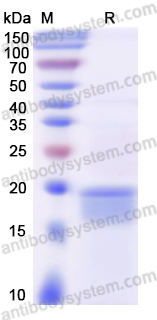Catalog No.
YHE70501
Expression system
E. coli
Species
Homo sapiens (Human)
Protein length
Lys265-Glu356
Predicted molecular weight
12.73 kDa
Nature
Recombinant
Endotoxin level
Please contact with the lab for this information.
Purity
>90% as determined by SDS-PAGE.
Accession
P49768
Applications
ELISA, Immunogen, SDS-PAGE, WB, Bioactivity testing in progress
Form
Lyophilized
Storage buffer
Lyophilized from a solution in PBS pH 7.4, 0.02% NLS, 1mM EDTA, 4% Trehalose, 1% Mannitol.
Reconstitution
Reconstitute in sterile water for a stock solution. A copy of datasheet will be provided with the products, please refer to it for details.
Shipping
In general, proteins are provided as lyophilized powder/frozen liquid. They are shipped out with dry ice/blue ice unless customers require otherwise.
Stability and Storage
Use a manual defrost freezer and avoid repeated freeze thaw cycles. Store at 2 to 8°C for frequent use. Store at -20 to -80°C for twelve months from the date of receipt.
Alternative Names
Presenilin-1, PS-1, 3.4.23.-, Protein S182, Presenilin-1 NTF subunit, Presenilin-1 CTF subunit, Presenilin-1 CTF12, PS1-CTF12, PSEN1, AD3, PS1, PSNL1
A Review Article on Oxidative Stress Markers F2-Isoprostanes and Presenilin-1 in Alzheimer's Disease., PMID:40511089
Combating multiple aetiologies of Alzheimer's disease to rescue behavioural deficits., PMID:40502821
Benchmarking AlphaMissense pathogenicity predictions against APP, PSEN1, and PSEN2 variants of unknown significance., PMID:40486492
Chronic social isolation-unpredictable stress induces early-onset cognitive deficits and exacerbates Aβ accumulation in the 5xFAD mouse model of Alzheimer's disease., PMID:40467855
From genetic roots to recent advancements in gene therapy targeting amyloid beta in Alzheimer's disease., PMID:40448320
Genetics and Epigenetics of Alzheimer's Disease: Understanding Pathogenesis and Exploring Therapeutic Potential., PMID:40447964
Acute targeting of N-terminal tau protein has long-lasting beneficial effects in Tg2576 APP/Aβ mouse model by reducing cognitive impairment, cerebral Aβ-amyloidosis, synaptic remodeling and microgliosis later in life., PMID:40442822
Late-Stage Activation of Toll-like receptor 3 Alleviates Cognitive Impairment and Neuropathology in an Alzheimer's Disease Mouse Model., PMID:40437286
Identification of presenilin mutations that have sufficient gamma-secretase proteolytic activity to mediate Notch signaling but disrupt organelle and neuronal health., PMID:40404063
The genetic risk factors, molecular pathways, microRNAs, and the gut microbiome in Alzheimer's disease., PMID:40374065
PF-06447475 Molecule Attenuates the Neuropathology of Familial Alzheimer's and Coexistent Parkinson's Disease Markers in PSEN1 I416T Dopaminergic-like Neurons., PMID:40363838
Combination of Epigallocatechin-3-Gallate and Tramiprosate Prevent Accumulation of Intracellular Aβ and Dysfunctional Autophagy-Lysosomal Pathway at Earliest Stage of Transdifferentiation of Mesenchymal Stromal Cells into PSEN1 E280A Cholinergic-like Neurons., PMID:40332390
Extracellular Competing Endogenous RNA Networks Reveal Key Regulators of Early Amyloid Pathology Propagation in Alzheimer's Disease., PMID:40332030
Presenilin 1 hemizygosity has no overt deleterious phenotypic outcomes in sheep: Potential implications for therapeutic targets in Alzheimer's disease., PMID:40315540
Early presentation of spastic paraparesis in individuals carrying PSEN1 mutations: a clinical and genetic analysis., PMID:40307832
Presenilin 1 M139I mutation regulates the microRNA-34a-mediated neurogenic locus notch homolog protein 1 signaling pathway in an early-onset Alzheimer disease cell model., PMID:40286338
Spectrum of γ-Secretase dysfunction as a unifying predictor of ADAD age at onset across PSEN1, PSEN2 and APP causal genes., PMID:40281586
Single-Cell Transcriptional Analysis Reveals the Mechanism of AZD6738 in HCC Immunotherapy via EZH2 Targeting., PMID:40255471
Impaired synaptic plasticity in behaving mice by inactivation of presenilin and accumulation of the neurexin gamma-secretase proteolytic substrate., PMID:40187476
Seeding-competent early tau multimers are associated with cell type-specific transcriptional signatures., PMID:40183825
Religious stress coping is associated with lower entorhinal tau pathology and better memory performance in autosomal dominant Alzheimer's disease., PMID:40179230
Clinical Significance of Early-Onset Alzheimer's Mutations in Asian and Western Populations: A Scoping Review., PMID:40149496
Polyoxometalates bind multiple targets involved in Alzheimer's disease., PMID:40119889
Insights From TgF344-AD, a Double Transgenic Rat Model in Alzheimer's Disease Research., PMID:40116546
Connectome-based predictive modeling of brain pathology and cognition in autosomal dominant Alzheimer's disease., PMID:40110659
Tau-PET pathology in the subregions of the amygdala and its associations with cognitive performance and neuropsychiatric symptoms in autosomal dominant Alzheimer's disease., PMID:40108701
Frequency of variants in Mendelian Alzheimer's disease genes within the Alzheimer's Disease Sequencing Project., PMID:40084664
Experimental basis for generating nonhuman primate models of frontotemporal dementia and Alzheimer's disease., PMID:40025729
Isoliensinine ameliorates cognitive dysfunction in AlCl3/D-gal-induced Alzheimer's disease-like mice by inhibiting the calcium signaling pathway., PMID:40020795
Identification and characterization of variants in PSEN1, PSEN2, and APP genes in Chinese patients with early-onset Alzheimer's disease., PMID:40016812
Newer Therapeutic Approaches in Treating Alzheimer's Disease: A Comprehensive Review., PMID:39989768
Retinal and Optic Nerve Lesions Correspond to Amyloid in Autosomal Dominant Alzheimer's Disease., PMID:39974084
γ-Secretase modulator resistance of an aggressive Alzheimer-causing presenilin mutant can be overcome in the heterozygous patient state by a set of advanced compounds., PMID:39972463
Daurisoline Inhibits Progression of Triple-Negative Breast Cancer by Regulating the γ-Secretase/Notch Axis., PMID:39933901
Alzheimer-mutant γ-secretase complexes stall amyloid β-peptide production., PMID:39932776
Amyloid-β can activate JNK signalling via WNT5A-ROR2 to reduce synapse formation in Alzheimer's disease., PMID:39907042
Gene Expression Signatures of Immaturity, Decreased pH, and Neural Hyperexcitation in the Hippocampus of Alzheimer's Disease Model Mice., PMID:39907034
The landscape of autosomal-dominant Alzheimer's disease: global distribution and age of onset., PMID:39903689
Evaluating pathogenicity of variants of unknown significance in APP, PSEN1, and PSEN2., PMID:39875235
γ-secretase facilitates retromer-mediated retrograde transport., PMID:39865938
Cytoplasmic expression of trans-active response DNA-binding protein-43 in aged mice display hippocampal sclerosis-like degeneration and neuronal loss with reduced lifespan., PMID:39864404
Basal forebrain global functional connectivity is preserved in asymptomatic presenilin-1 E280A mutation carriers: Results from the Colombia cohort., PMID:39863323
Presenilins as hub proteins controlling the endocytic and autophagic pathways and small extracellular vesicle secretion., PMID:39815792
ApoE3 R136S binds to Tau and blocks its propagation, suppressing neurodegeneration in mice with Alzheimer's disease., PMID:39814008
The ER protein CANX (calnexin)-mediated autophagy protects against alzheimer disease., PMID:39813987
Exome sequencing reveals a rare damaging variant in GRIN2C in familial late-onset Alzheimer's disease., PMID:39810256
Multi-omics analyses of early-onset familial Alzheimer's disease and Sanfilippo syndrome zebrafish models reveal commonalities in disease mechanisms., PMID:39798820
Bioinformatics and Deep Learning Approach to Discover Food-Derived Active Ingredients for Alzheimer's Disease Therapy., PMID:39796418
Is the Relationship Between Cardiovascular Disease and Alzheimer's Disease Genetic? A Scoping Review., PMID:39766777
Skin and Induced Pluripotent Stem Cells as Biomarkers for Neurodegenerative Diseases., PMID:39766775

